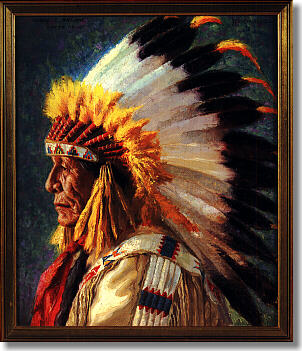Osage County, OK
 From early tribal tradition, and from the research of archaeologists and historians, and the ancestors of the Osage, we know that this tribe of Indians was closely affiliated with the Siouan, or Dhegiha tribes,
From early tribal tradition, and from the research of archaeologists and historians, and the ancestors of the Osage, we know that this tribe of Indians was closely affiliated with the Siouan, or Dhegiha tribes,their dialect being much the same.
The name, Osage, is a corruption of the tribal name, Wa-Zha-Zhe, that the Indians used themselves, the meaning and derivation is not clear.
The first recorded note of the Osage was by Marquette in 1673. His writing placed them on the Osage River in present Vernon County, Missouri, where they were still established, nearly 100 years later in 1759.
There is little known about the Osage from this time until the treaty at St. Louis in 1804. Here we find the explorers and French traders marrying into the Osage tribe. Almost from the beginning, trading with the Indians became a lucrative enterprise, for the white man and the spead of trade brought a large number of tribes into contact with the French, Spanish and English. All groups trying to make allies among the Indians.
The Osage signed their first treaty with the United States in 1808, ceding to the Federal Government lands new comprising over half the state of Missouri and northern Arkansas, including their old village located on the Little Osage River.
When the Osage signed the treaty of 1825 at St. Louis, they ceded all their lands to the United States, all of Oklahoma north of the Arkansas and Canadian Rivers, northwestern Arkansas, western Missouri and nearly half of Kansas.
Osage County today is the largest county in Oklahoma. Big Prairie? Imagine the vastness of 37,000 acres of prairie, disturbed only by the thunder of more than 800 bison. This is the Nature Conservancy's Tallgrass Prairie Preserve, lying just 17 mile north of Pawhuska. At one time, the American prairie spanned across fourteen states. Now, less than 10% of this original prairie remains, but the prairie surrounding Pawhuska is still flourishing. On the Tallgrass Prairie alone, over 600 plant, 300 bird, and 80 mammal species have been identified. Film teams from around the world have discovered the Tallgrass Prairie as a place of ecological richness and uncommon beauty.
Real Cowboys? Over 250,000 head of cattle thrive on the bluestem grass on over 1,000 ranches around the county. Numerous rodeos and ropings throughout the year give these real American cowboys the chance to showcase their immense skill to the public.
Explore Osage County
The Victorian Theater
The Victorian Theater is a groundbreaking, exciting new concept in combining fine dining, entertainment and retail sales all located in one facility designed to bring patrons the ultimate multisensory experience.
Pawhuska, OK Dinner TheatresOsage County Courthouse
The County Courthouse building was completed in 1914. Osage County is the largest county in Oklahoma, twice as large as the entire state of Rhode Island and Delaware combined.
Pawhuska, OK Historic CourthousesBoy Scout Monument
The first boy scout troop in America was organized in Pawhuska, Osage County, Oklahoma, in May, 1909
Pawhuska, OK MonumentsBlacksmith House
Built in 1871, this 5 room house with native timbers and 18" thick sandstone walls was the first to be built in Pawhuska. When the Osage were moved from Kansas, Sid Delarue, a Swiss blacksmith, was promised the house if he would come to care for their horses. Listed on the
Pawhuska, OK Pioneer HistoryImmaculate Conception Catholic Church
This church is known widely as the "Cathedral of the Osage". Special permission from the Vatican had to be granted to depict living tribal members in the glorious stained glass that was crafted in Munich, Germany in 1919
Pawhuska, OK Historic ChurchesTallgrass Prairie Preserve
Originally spanning portions of 14 states and covering over 142 million acres, the tallgrass prairie was one of North America's major ecosystems. Today, less than 10%
Pawhuska, OK Nature PreservesOsage Indian Heritage
From early tribal tradition, and from the research of archaeologists and historians, and the ancestors of the Osage, we know that this tribe of Indians was closely affiliated with the Siouan, or Dhegiha tribes, their dialect being much the same.
Pawhuska, OK Ethnic HeritageOsage County Historical Museum
One of the three museums in and around Pawhuska, the Osage County Historical Museum is housed in the historic Santa Fe Depot built in 1922
Pawhuska, OK MuseumsBronze Sculptures
"Okie Cowboy"
"I spent much of my boyhood with a cowboy, the genuine article. This bronze sculpture reminds me of him, a man who had time for a boy." - Pawhuska Sculptor, John D. Free
A gift to the city of Pawhuska from Strat and Bobbie Tolson, 2000
112
Pawhuska, OK ArtsRexall Drug Store
Constructed in 1907, the building has always served the community as a drug store. Its affiliation with Rexall dates to the 1920s. The second floor was used for many years by various professions including law, dentistry, and photography.
Hominy, OK Historic Buildings"City of Murals"
Artist Cha' Tullis, a Blackfoot Indian, began painting giant murals in Hominy in April 1990. Along with other local artists, 40 and more spectacular murals depict Indian folklore and are a delight to behold, located on various buildings throughout town.
Cha'
Hominy, OK Arts